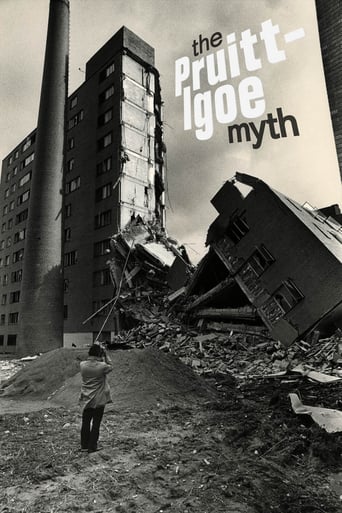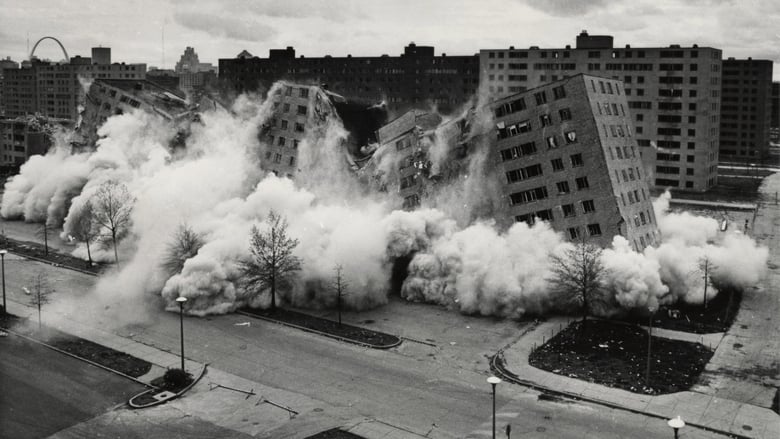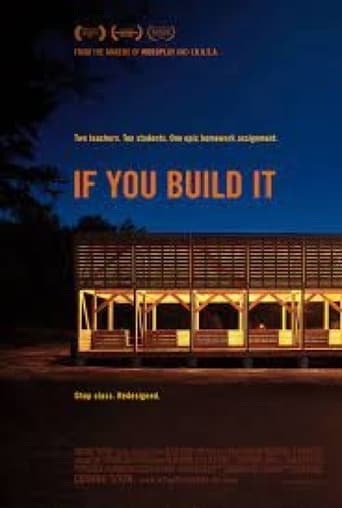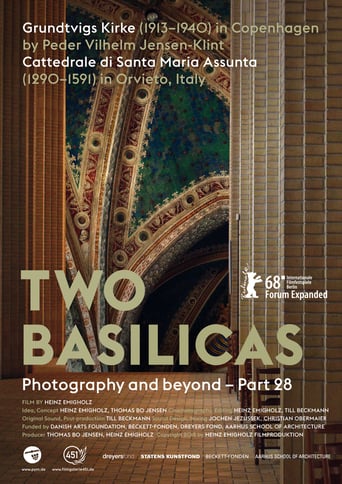

The Pruitt-Igoe Myth (2012)
Destroyed in a dramatic and highly-publicized implosion, the Pruitt-Igoe public housing complex has become a widespread symbol of failure amongst architects, politicians and policy makers. The Pruitt-Igoe Myth explores the social, economic and legislative issues that led to the decline of conventional public housing in America, and the city centers in which they resided, while tracing the personal and poignant narratives of several of the project's residents. In the post-War years, the American city changed in ways that made it unrecognizable from a generation earlier, privileging some and leaving others in its wake. The next time the city changes, remember Pruitt-Igoe.
Watch Trailer
Cast
Similar titles
Reviews
A lot of perfectly good film show their cards early, establish a unique premise and let the audience explore a topic at a leisurely pace, without much in terms of surprise. this film is not one of those films.
Easily the biggest piece of Right wing non sense propaganda I ever saw.
It’s sentimental, ridiculously long and only occasionally funny
A terrific literary drama and character piece that shows how the process of creating art can be seen differently by those doing it and those looking at it from the outside.
I watched this last night for the first time and afterwords I just wanted to find a government employee and slap them. I have always been of the opinion that the government has no business in the business of housing. The tragic story of Pruitt Igoe proves that our government at every level is unable to manage housing and needs to get out of it. This documentary focuses on actual residents of the projects who tell the most interesting stories of the years they spent living there. Many of their memories are happy ones of when the project was brand new and that the residents did appreciate the modern apartments they had. The problem was the completely stupid welfare policies, funding policies and many structural features of the buildings themselves. Had the government kept families together instead of ripping them apart and kept up on the maintenance and security budgets these apartments might still be there today providing much needed housing. The vintage file footage of the projects, especially the interiors was very cool and interesting. I came away with a much better understanding of what the issues were contributing to the failure of the projects. This is a must see for anyone interested in the history of public housing in America.
The Pruitt Igoe myth reveals a saddening chapter in this nation's urban history. It covers what could have been the rise of a real housing solution for the urban poor but what ended up being a lesson for urban planners everywhere and the talking. For those who want to end government subsidized programs like public housing. The film covers many issues concerning the urban environment like the housing problem urban poverty and segregation. These are problems that plagued every major city in the United States but the film of course focuses on the Pruitt Igoe housing complex and the city of st. Louis. St Louis continues to this day to be one of the most segregated cities in America. Using a map you can drop a line down Delmar boulevard, one of the main thoroughfares of the city, and separate the majority of the black population from the white population. The divide becomes even worse when you leave the city and go into St Louis County, where all of North County is poor African American communities while West and South County are more affluent white suburbs. I would even argue that this film provides insight into many of the problems the st. Louis sees today including gang violence in the Michael Brown killing that happened in Ferguson Missouri one of the North County suburbs. If you don't understand urban poverty as a whole, and especially why these issues occur in St Louis, the Pruitt Igoe myth reveals the very beginning of the story. The original idea behind the construction of Pruitt Igoe is that the public sector could offer a better solution to housing the urban poor than the private sector could. After World War Two, many African American families from the south migrated north to urban centers in search of work and often found themselves living dilapidated, unsanitary slums. The slumlords who owned these properties refused to do anything about it because they were making so much money by taking advantage of these people. As one interviewee described Pruitt Igoe, what began as almost literally a glimmering hope for poor and working class families to have a housing option close to where they worked, soon turned into a crumbling shell of what could've been. Lack of proper funding to maintain the buildings soon left elevators inoperable, lights broken, and windows shattered. Originally the plan was to use the tenants rent to pay for upkeep and maintenance, however it soon became very evident that this would not cover the entire cost, and the funding that was cut by politicians for public housing was sorely missed.So why wasn't the rent enough? Part of this had to do with the poor planning that took place by the planners, business leaders, and politicians foresaw huge growth in the future of st. Louis and jobs a plenty for everyone. The girls of course never came, and St.Louis fell into a downward spiral as industrial jobs left the city. New jobs were being created, but only out in the suburbs are African American families were not allowed who own property either through redlining or racist practices by real estate brokers and the surrounding communities. So the number of people renting in Pruitt Igoe dwindled and the forecasted money to be used for maintenance never materialized. We know now that the racially charged practice of keeping African-American families centered in the inner cities while white family's moved away was a very real phenomenon that was influenced by politicians and lawmakers at the time. Looking back, we are also aware of the imminent crumbling economies of the inner cities. However I would argue that it is not necessarily wrong of the planners of St. Louis to have approached Pruitt Igoe as they did. They filled a need that would be very helpful to the poor families living in the slums, quality housing. It was of course a very short sighted plan and perhaps some of the issues of Pruitt Igoe could have been avoided with just a little more funding to help keep the buildings well maintained and a desirable place to live for families who did not have many other options. However there has been no response to the obvious racial and class divide that this project helped to create and there can be no tonight that I go helped mold the city into what it is today. The racial boundary lines drawn by by the planners at this time continue to be the racial boundary lines we see in modern St Louis and that continued segregation and concentration of poverty has been the downfall of St. Louis in the 21st century. As much press the Chicago gets about being the murder capital of the US in 2011 the murder rate per 100,000 in St Louis was nearly twice that of Chicago's at 35. 3 according to the Federal Bureau Investigations Another possible explanation for this that was mentioned in the documentary was that since the city of St Louis boundaries are very rigid and constricted, that there is no the city except for the impoverished, crime ridden neighborhoods. But these neighborhoods formed in the city for a reason, and that's because post World War Two, this is the only place where poor families could live. The decades-long struggle that has been brewing in these neighborhoods between police and the citizens of these areas of the city should unfortunately leave little surprise in many St.Louisans minds that the Michael Brown tragedy would occur in the north side of the city. The racial tensions here are nothing new and has been brewing since the days of Pruitt Igoe. We may not be able to change what has happened in the past, but we certainly do know what has become of it and urban planners must take this into consideration for any future endeavors in the inner cities of America.
Prof. Cordova UPP 101 October 24, 2014In The Pruitt-Igoe Myth, director Chad Freidrichs, gives viewers an in-depth look at the Pruitt-Igoe project, one of St. Louis' failed attempts to urbanize the city. In this documentary, Freidrichs focuses on dispelling the myths that surround the project by interviewing past residents and establishing the real cause of why projects Pruitt-Igoe failed. In addition, this documentary sheds light on the bigger issue, of why housing projects in general fail in America.The main argument of the film is built to dispel the myths about housing projects, that Pruitt-Igoe fueled. When most people think about housing project and why they fail, they blame violence, crime, drugs, and poverty. While these things are commonly found in housing projects, they are not to blame. To prove this, Friedrichs starts by discussing the beginning of urban renewal. In 1949 the Housing Act was passed. Legalized and funded, St. Louis started urban renewal by clearing the slums and building new public housing units, Pruitt Igoe. Pruitt-Igoe was conceived to replace the tenement homes of poor residents throughout the St. Louis. The idea was to replace the slums with new high-rises, and this would solve the issue of poor neighborhoods. However this would not work out in the end. As I previously mentioned when people think of housing projects they think of crime as the root of their problem. This was not the case for Pruitt Igoe. Friedrichs points to a lack of funding as the cause of Pruitt Igoes failure in the documentary. The documentary looks in-depth at how a lack of funding led to the deterioration of Pruitt Igoe. They say the project was doomed from the beginning because the city did not have a solid plan on how to continue to fund Pruitt Igoe. When the planning for the building started, the city wrote in the plans that the rent residents would pay would never increase. As the years went on funding dwindled and the buildings deteriorated. The documentary interviewed some past residents and they told stories of how the grounds keepers stopped taking care of the building, no repairs or updates were made to the buildings, and how basically their was no one to take care of Pruitt Igoe. Another argument the documentary made was that people who live in housing projects have a community there. Many of the interviews shown in the documentary support this. Everyone they interviewed had positive happy memories of living in Pruitt Igoe despite poor conditions toward the end. They boasted of growing up there as children and always having someone to play with. The apartment styled building made it so everyone knew each other. Friedrichs use of interviews took the focus off of Pruitt Igoe being a failure and focused on the community aspect. Overall, this documentary dispels a lot of myths that surround housing projects. The documentary takes a look at a controversial aspect of urban planning over a course of decades in Pruitt Igoe. Many people put housing projects to the back of their mind or look at them as negatives blaming their problems on the residents that inhabit them. As a person who was grown and raised in St. Louis, I didn't even know that Pruitt Igoe existed as it has since been torn down. I would recommend this documentary, as I think it shows an important part of our history and portraits Pruitt Igoe in a positive light which it and its' residents deserve.
This is a fascinating and excellent documentary about the collapse of a public housing high-rise project in St. Louis, MO. Pruitt-Igo, a massive block of high-rise apartments was supposed to offer hope to the poor living in dismal slums. It was typical of similar disasters in other cities, for example Cabrini-Green and Robert Taylor in Chicago and ones in the Bronx. At first the residents were happy to be able to move out of the slums which were being torn down and into the modern, clear, cheerful apartments of Pruitt-Igoe. Former residents who were there at the beginning in the 1950's remember with nostalgia being able to live for the first time in a clean, bright apartments. Evidently at the beginning the residents got along splendidly. The architecture of these high-rises has been criticized for being inhuman and blamed for causing the monstrous social problems which ensued, but evidently at first the architecture didn't effect people that way. Children played safely in the halls and moms communicated freely between apartments.There were from the beginning some rather annoying glitches, the biggest of which was a rule that men couldn't live in the apartments. This meant that husbands had to either live apart from their wives and children or stow away in their wives' apartments. It's hard to see why rules like this were created, but easy to see what the ultimate effect would be. Poor families would be split up and an epidemic of out-of-wedlock births would follow. But that would be farther down the road and there are numerous other forces contributing to the epidemic of out-of-wedlock births.Another short-sighted rule was a law that forbid increases in rent. Since rent went to maintenance there wasn't enough money to maintain those huge high-rises. Elevators jammed, the stairwells became toilets. Jobs left the city and population left at the same time. Whites fled to the suburbs leaving Pruitt-Igoe almost entirely black. The towers became shabby and dilapidated. Vandals and criminals moved in and in a couple of decades what started out as a bright and noble crusade to help the needy crashed to the ground in flames. The film wants to blame the particular conditions of St. Louis at the time for the destruction of Pruitt-Igoe, but although those conditions were the proximate cause of the catastrophe, the entire plan was built on quicksand from the beginning. Because it was a huge government project which required huge amounts of money to maintain there was no way that such a project could be successfully centrally planned and still function. It was just too big, there were just to many false assumptions, and just too many political considerations at work.This is true for public housing everywhere. Almost anywhere you go you'll find that public housing, whereas it might not be as bad as Pruitt-Igoe, is still a breeding ground for crime and social dysfunction. Though the film makers try to deny the obvious, government attempts at social engineering are doomed to fail by their very nature. Lumbering government bureaucracies can't adapt to changing conditions. Rules and regulations created by bureaucrats look good in theory but are unworkable in practice. The idea that an entire dependent class might be created as a result of the best of intentions was never considered by the planners. In some cities, like Chicago, the black out-of-wedlock birthrate is now approaching 85%. Some could argue, with just cause, that it is the nanny state programs of the Great Society that are directly responsible. Only a liberal big-government project could fail in such a spectacular way.



